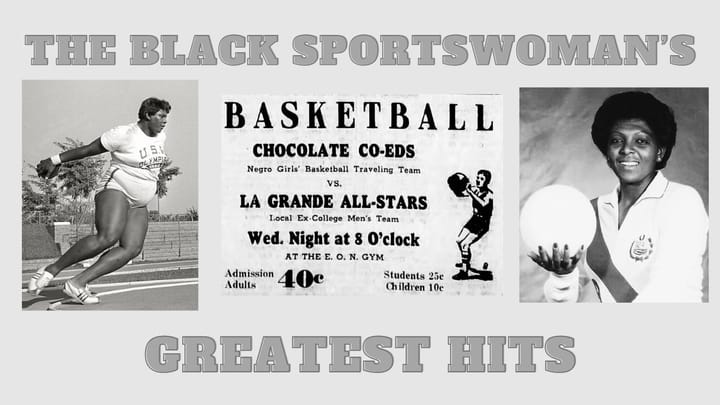1932 Olympics: What was it like for Tidye Pickett & Louise Stokes?
What was the 1932 Olympics like for two Black women?

July 16, 1932. Evanston, Illinois. Dyche Stadium. The weather conditions: heat and humidity.
Tidye Pickett and Louise Stokes began their 1932 Olympic journeys with the U.S. women’s track and field trials for the 1932 Games in Los Angeles.
Pickett and Stokes are the first Black women to be selected for the U.S. Olympic team, and the trials were just the beginning.
The trials took place on a Saturday. That day, the competitors for the 100 and 4x100 relay ran seven preliminary, quarterfinal, semifinal, and final heats in 100 degree weather, according to Doris H. Pieroth in her book about the women of the 1932 Olympics.
In the 100 meters finals, Louise Stokes finished fourth and Tidye sixth in the official record books, with Ethel Harrington finishing first in the final heat.
But as is written in the official history of the U.S. Olympic Trials, “Harrington, a local athlete, mistook the finish line in her (preliminary) heat and failed to qualify, but was permitted to run in the final, to the chagrin of the other competitors, and duly won.”
Harrington had only run in that one prelim heat while everyone else had run multiple times that day.
But one of the judges, George T. Donoghue, advocated on behalf of Pickett, moving her from seventh to sixth, and therefore qualifying her for the Olympics.
Both Black sportswomen would head to L.A. as members of the 4x100 relay pool.
Two days later, the 1932 U.S. women’s Olympic Track & Field team left Chicago’s Union Station and headed west by train.
On the train, Pickett and Stokes shared a room, writes Matt Osgood, and during the ride, Mildred “Babe” Didrikson threw water on them while they were sleeping.
When the team stopped in Denver, they worked out in Denver University's stadium and made guest appearances on a radio show.
Some of the athletes, at least.
“There was a fundraising dinner for the women’s track team in a hotel in Denver, but we weren’t invited,” Pickett said. “All the other girls had private rooms, went to the banquet, were interviewed by the reporters. Louise and I shared a room in the attic and ate our dinners on trays.”
But in Los Angeles, at The Chapman Park everyone had the same accommodations. This was the first Games with an Olympic Village, the three-tiered podium, and the medal ceremony, according to David Goldblatt’s Global History of the Olympics.
Goldblatt also says in his book that, “In Los Angeles, the presence of African Americans as a part of the American sporting nation was widely discussed in the popular press.”
Many mainstream newspapers and of course the Black press wrote about Pickett and Stokes that year.
On August 19, 1932, The California Eagle published two articles about the athletes, one saying they were enjoying their stay at The Chapman Park hotel and calling Pickett an accomplished pianist.
Pickett and Stokes didn’t run in the 1932 Olympics. But The California Eagle wrote that the two were expected to compete.
“For publication of their names as two of the four girls in the relay team on Saturday had led everyone to believe that fairly and impartially they had been selected to help represent the U.S. on the relay team.”
The Eagle also wrote that the cause of the change was not revealed. There’s also no publicly available record of what took place during practices or a story behind George Vreeland’s decision.
Harry Levette from the Eagle said, “They were much disappointed at not being allowed to run but accepted it all with rare good sportsmanship.”
Years later, some white teammates say they repeatedly beat Pickett and Stokes in practice. But Pickett says she repeatedly beat the girls they were replaced with.
“I knew I was better than some of them,” Pickett said. “It was politics. Politics and sports, sports and politics, they’ve always gone together.”
I haven’t seen many instances of Louise Stokes speaking on the subject of the Olympics, or about herself at all.
Her son shared insight with METER on her potential thoughts on what happened during the 1932 Olympic Games.
“As strange as it may sound, mostly all of the information [about my mother] comes from family members and other people,” he said. “My mother talked a little bit about [the Olympics] but not that much. I’m assuming now, after all these years, it’s because of the hurt and pain she went through and didn’t want to keep reliving it every time someone asked her.”
Bibliography:
Women of the 1932 Olympics by Doris H. Pieroth (book)
Tidye Pickett and Louise Stokes Never Got Their Shot by Matt Osgood (article)
The History of the United States Olympic Trials - Track & Field by Richard Hymans (PDF)
Tidye Pickett Interview with Northern Illinois Alumni News (photo)
The Games: A Global History of the Olympics by David Goldblatt (book)
The California Eagle (newspaper)The Race of a Lifetime by Heather Mayer Irvine (article)



Comments ()